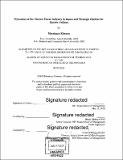Dynamics of the electric power industry in Japan and strategic options for electric utilities
Author(s)
Kimura, Masakazu
DownloadFull printable version (12.48Mb)
Other Contributors
Technology and Policy Program.
Advisor
Henry Birdseye Weil.
Terms of use
Metadata
Show full item recordAbstract
The Japanese electric power industry is undergoing drastic reform since a devastating earthquake struck Japan on March 11, 2011. This disaster triggered a tsunami, which caused major damage to the nuclear power plants in Fukushima and led to the shutdown of all the nuclear power plants in the country. This incident facilitated deregulation of the Japanese electric power industry. Japan's electricity retail market became fully liberalized in 2016 and vertically integrated electric utilities are required to unbundle their organization by 2020 under the law. Furthermore, we are seeing external drivers reshaping this industry that were not concerns decades ago. This ever-evolving environment is pushing Japanese electric utilities to urgently change their traditional business model in order to outpace the competition while maintaining an affordable and reliable supply of electricity. This thesis discusses dynamics that will be shaping this industry in the next few decades by focusing on electric utility companies' perspective. In this regard, I identified drivers impacting the industry and developed a system dynamics model to understand the dynamics. After running simulations to see how those drivers identified would impact the future business of electric utility companies in Japan, it can be concluded that if electric utilities do not respond strategically in today's rapidly evolving business environment, the reserve margin will go below the required level starting in 2025 and they will decline by losing more than half of their existing customers by 2040. And the most effective approach to prevent themselves from taking this path is to focus on creation of new energy technologies and services based on research and development. The conclusion drawn from this thesis requires Japanese electric utilities not only to focus on building a risk-taking and innovative culture in their organization but also to collaborate with their stakeholders as necessary to create a sustainable business environment for the industry as a whole. To achieve this, it is imperative for the management of electric utilities to have a notion of stepping up and driving the industry instead of being driven by their environment.
Description
Thesis: S.M. in Management of Technology, Massachusetts Institute of Technology, Sloan School of Management, 2018. Page 94 blank. Cataloged from PDF version of thesis. Includes bibliographical references (pages 80-84).
Date issued
2018Department
Sloan School of ManagementPublisher
Massachusetts Institute of Technology
Keywords
Sloan School of Management., Technology and Policy Program.